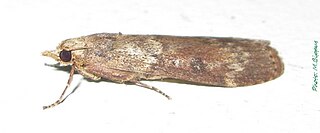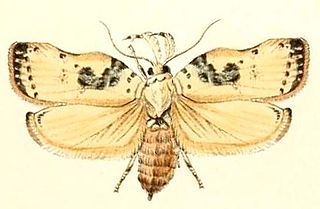
Gyrtona is a genus of moths of the family Euteliidae first described by Francis Walker in 1863.
Olulis is a genus of moths of the family Noctuidae first described by Francis Walker in 1863.

Lamoria is a genus of small moths belonging to the family Pyralidae.

Izatha copiosella is a moth of the family Oecophoridae. It is endemic to New Zealand, where it is found on the south-eastern parts of the North Island and throughout the South Island except the West Coast. Larvae are found in dead wood and are likely to use kōwhai species as hosts. The adults are night fliers and are attracted to light. They are on the wing in January and February.

Tonica is a genus of moths of the family Depressariidae.
Tonica centroluta is a moth in the family Depressariidae. It was described by Alexey Diakonoff in 1966. It is found on Borneo.
Tonica melanoglypha is a moth in the family Depressariidae. It was described by Alexey Diakonoff in 1966. It is found on Java.
Tonica peripsacas is a moth in the family Depressariidae. It was described by Alexey Diakonoff in 1966. It is found on Sulawesi.
Tonica pharmacis is a moth in the family Depressariidae. It was described by Alexey Diakonoff in 1966. It is found on Sumatra.
Tonica syngnoma is a moth in the family Depressariidae. It was described by Alexey Diakonoff in 1966. It is found in Malaysia.
Tonica argessa is a moth in the family Depressariidae. It was described by Alexey Diakonoff in 1967. It is found on Luzon in the Philippines.
Tonica citrantha is a moth in the family Depressariidae. It was described by Alexey Diakonoff in 1967. It is found on Luzon in the Philippines.
Tonica nigrimarginata is a moth in the family Depressariidae. It was described by Alexey Diakonoff in 1954. It is found in New Guinea.
Tonica cyanodoxa is a moth in the family Depressariidae. It was described by Edward Meyrick in 1924. It is found on New Guinea.
Tonica lagaropis is a moth in the family Depressariidae. It was described by Edward Meyrick in 1928. It is found on Luzon in the Philippines.
Tonica malthacodes is a moth in the family Depressariidae. It was described by Edward Meyrick in 1914. It is found on New Guinea.
Tonica senescens is a moth in the family Depressariidae. It was described by Edward Meyrick in 1910. It is found on New Guinea.
Tonica barrowi is a moth in the family Depressariidae. It was described by Charles Thomas Bingham in 1907. It is found in Myanmar.

Tonica effractella is a moth in the family Depressariidae. It was described by Snellen in 1879. It is found in Australia, where it has been recorded from the Northern Territory, Queensland, New South Wales and Western Australia.
Tonica terasella is a moth in the family Depressariidae. It was described by Francis Walker in 1864. It is found on Borneo.




